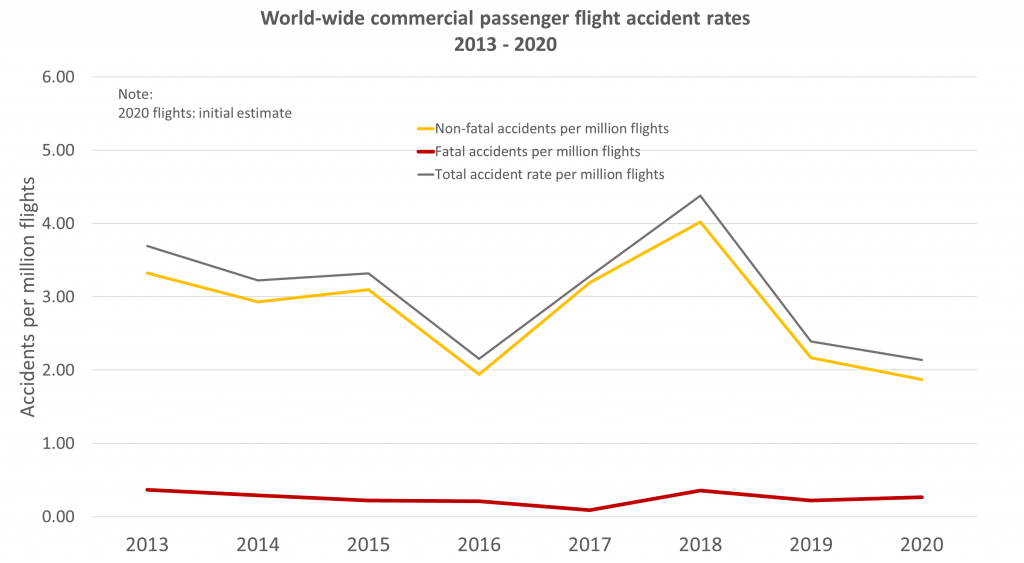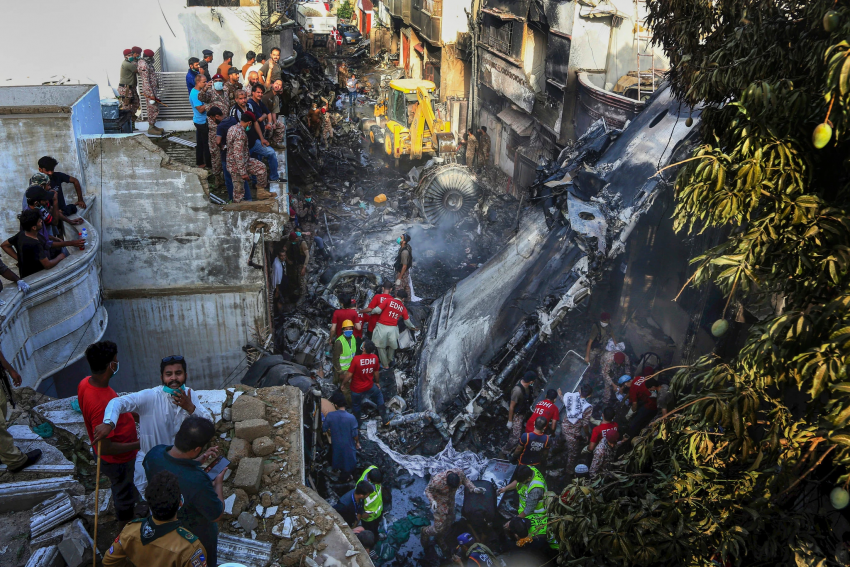No review of aviation in 2020 can ignore the enormous impact that the COVID-19 crisis has had on the airline industry. As ever, To70’s civil aviation safety review examines accidents only to large passenger aircraft used by most travellers. (See our criteria in the Note below.) We include all contributory factors , whether related to technical performance, human performance and environmental conditions. We also include unlawful interference events, for example, the shooting down of a Ukrainian airliner in January, something that is excluded from other statistical summaries.
With a greatly reduced number of passenger flights in 2020 there were 40 accidents, 5 of which were fatal, resulting in 299 fatalities. In 2019 there were 86 accidents, 8 of which were fatal, resulting in 257 fatalities. 2017 remains an exceptional year with a historic low of only two fatal accidents, both to regional turboprops, resulting in the loss of only 13 lives.
At the end of 2020 the Boeing 737 MAX started its re-entry into service. After its long grounding and intense scrutiny over its flyability, it is now one of the most thoroughly tested aeroplanes in service. Whether or not that is enough to restore passenger confidence in the type remains to be seen. Issues surrounding the organisational culture at the FAA and Boeing and, in general, the system of delegating parts of the approval process to manufacturers are both still being actively discussed.
Whilst the accident rate for 2020 remains low, the circumstances around a number of the accidents is cause for concern.
Three of the five fatal accidents in 2020 and several of the non-fatal ones relate to aeroplanes that left the paved surface of the runway; runway excursions. Following the trend of other runway excursions these events have been contributed to by events leading up to the final approach and landing. The Turkish accident in February and the Indian one in August both occurred in heavy rain. The latter also, reportedly, landed with a strong tailwind. The accident in Pakistan in May followed an initial hard landing and go-around that appears to have damaged the engines, resulting in the undershoot on the subsequent approach. Flight performance calculations made prior to the approach and the timely use of the go-around manoeuvre remain key factors in accidents and more must be done to understand the role of the human and the technology in these situations as the truism that “no-one gets out of bed thinking that they are going to have an accident today”. Stable approaches remain a key success factor in successful landings and require all Airline, ANSP and Airport stakeholders to collaborate in what is a crucial phase of flight and more must be don’t to ensure this is effective. The last of the four fatal accidents is one that will be excluded from official statistics as it was ‘unlawful interference’; the shooting down of a Ukrainian airliner above Tehran in January.
The fatal accident rate for large aeroplane in commercial air transport is 0.27 fatal accidents per million flights. That is a rate of one fatal accident every 3.7 million flights. This years’ fatal accident rate is similar to the average of the last ten years.We know that traffic levels does not have a correlation to the number of accidents. 2020 has seen a significant decrease in traffic but the impact on human performance, including the wellbeing of our operational staff, has been significant and skill fade is recognised as a critical issue for our industry as we return to normal operations.

The fatal accidents to large passenger aircraft in 2020 were:
| Date (2020) | Type | Operator | State of Registration | State Accident Occurred | Fatalities |
| 8 January | Boeing 737-800 | Ukraine Intl. Airlines | Ukraine | Iran | 176 |
| 5 February | Boeing 737-800 | Pegasus Airlines | Turkey | Turkey | 3 |
| 7 May | Boeing 737-700 | Southwest Airlines | USA | USA | 1 (1) |
| 22 May | Airbus A320-200 | Pakistan Intl. Airlines | Pakistan | Pakistan | 98 (2) |
| 7 August | Boeing 737-800 | Air India Express | India | India | 21 |
(2) 97 on board, plus 1 on ground
Whilst the aviation industry looks to recover in 2021 and beyond, significant efforts are being placed on assuring that the low-level of operations these past months do not adversely affect safety in the future. The training of all operational staff and the need to ensure that we provide appropriate skill refreshers continually through the return to normal operations, noting a possible yo-yo effect in traffic levels, is a priority. The return to service of large numbers of aeroplanes that have been ‘parked’ during the pandemic is also a topic that will require attention. Also, at airports, work to address the maintenance of airport surfaces that have been used as aeroplane parking spaces must be carried out appropriately. 2021 will be a challenging year for the industry we must not become complacent as travel restrictions ease and traffic levels increase, although we don’t expect a return to 2019 levels in some regions until 2024 or beyond. The aviation industry needs to intensify its focus on the ensuing that the fundamentals of safe flight are properly addressed.
Methodology
To70 uses official figures reported by States to the UN’s aviation agency, ICAO, to determine the number of civil aviation flights that have taken place in any given year. The actual figures, published by the air transport organization, IATA, are used to estimate the current year’s figures. We update our database each year when the actual flight numbers data for the previous year becomes available. This year, there is a little uncertainty in the flight data due to the disrupted nature of the year’s operations and the way that passenger flights were used to carry cargo and no passengers.
Accident data is derived from publicly-available databases, aviation authority websites and official sources such as ICAO’s ADREP database. Our analysis documents accidents to passenger flights commercial air transport operations in aeroplanes with a maximum take-off mass of 5700 kg or above. This excludes a number of small commuter aeroplanes in service around the world, including the Cessna Caravan (maximum take-off mass 3629 kg). Certain relevant exceptions may be included regarding smaller turbo-prop aeroplanes just below this mass limit (e.g., the De Havilland Twin Otter with a maximum take-off mass of 5670 kg). Accidents to military flights, training flights, private flights, cargo operations and helicopters are excluded. Unlike statistics produced by IATA and ICAO, accidents involving unlawful interference are included in our analysis.
As the vast majority of commercial air transport operations take place with large aeroplanes, the effect of the excluded types on the accident rate is very small.
Main photo: Fareed Khan/Associated Press
About To70. To70 is one of the world’s leading aviation consultancies, founded in the Netherlands with offices in Europe, Australia, Asia, and Latin America. To70 believes that society’s growing demand for transport and mobility can be met in a safe, efficient, environmentally friendly and economically viable manner. To achieve this, policy and business decisions have to be based on objective information. With our diverse team of specialists and generalists to70 provides pragmatic solutions and expert advice, based on high-quality data-driven analyses. For more information, please refer to www.to70.com.


Hi Adrian,
First of all thanks for the article and thanks for trying to improve flight safety.
As someone who cares a great deal about flight safety, I find it a bit off-putting to read phrases of the type “only X amount of people died in a given year”, with an emphasis on the word “only”. These are real people who perished. Even if 1 person dies it’s still a life lost. Doesnt make it better if it’s ONLY 1 person.
Respectfully,
Pavlos